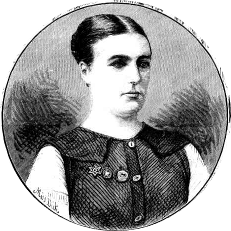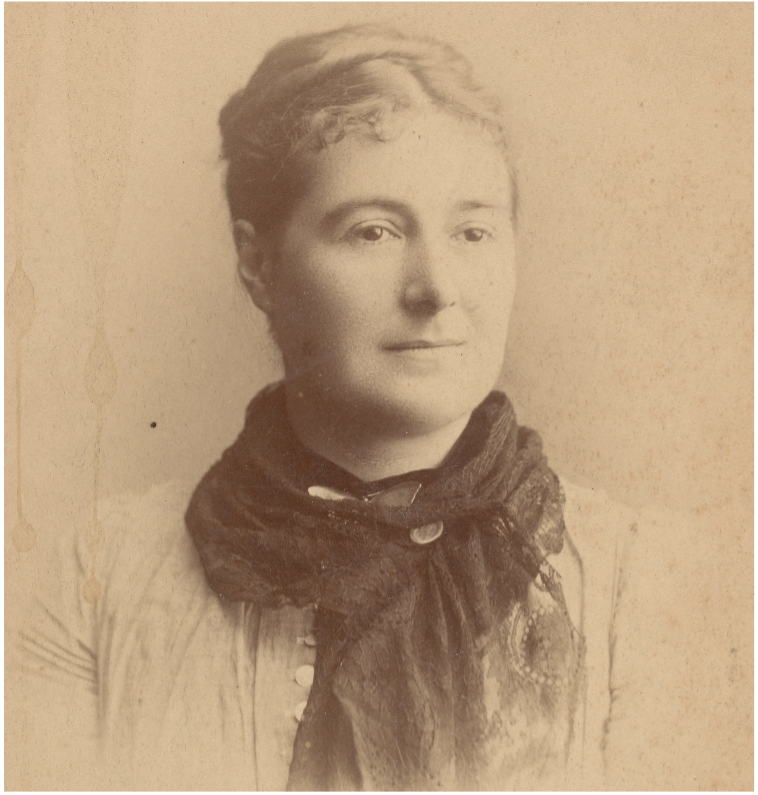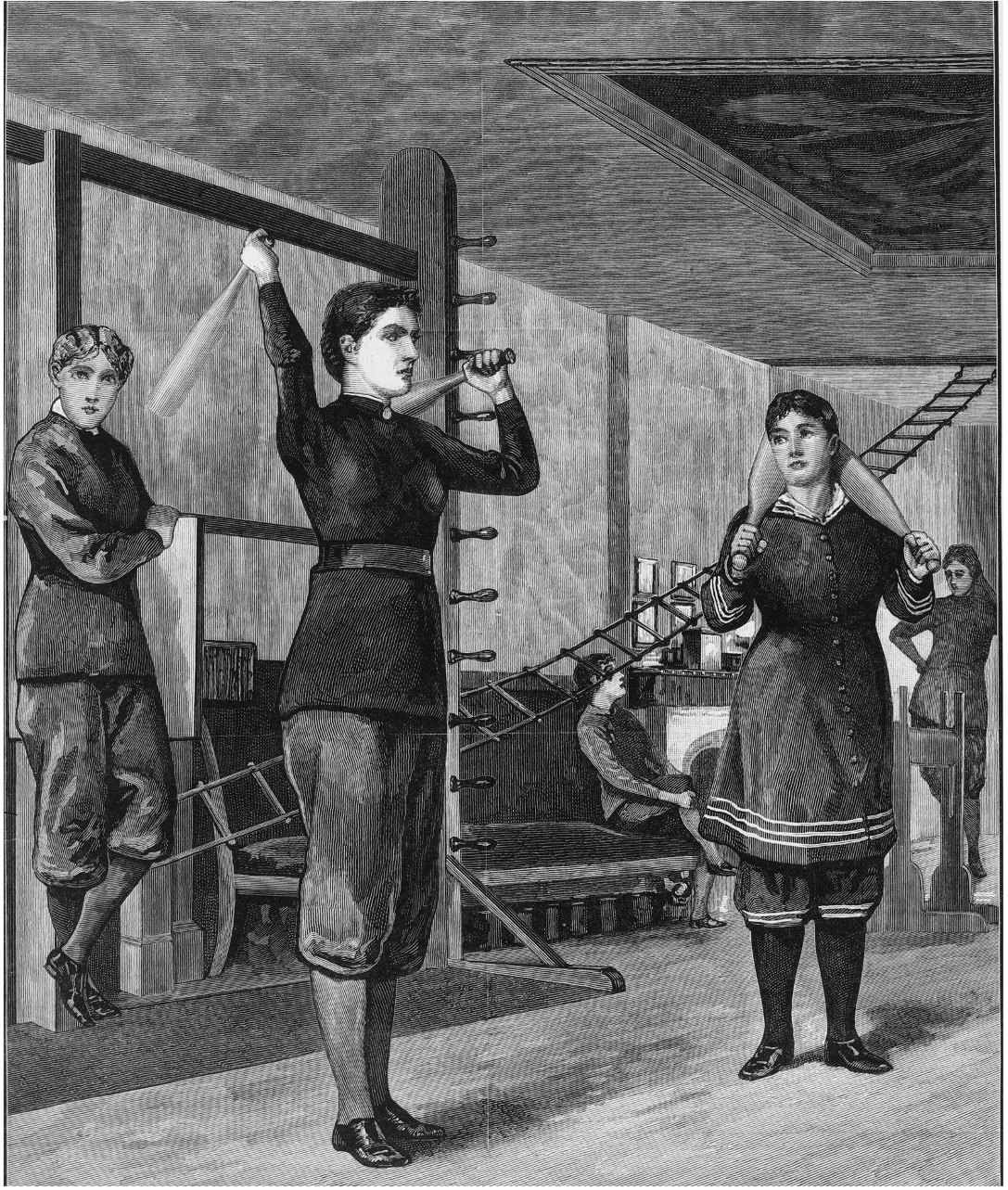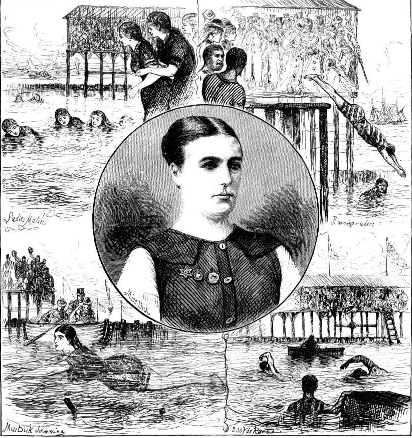Collingwood Notables Database
Harriet Elphinstone Dick
1852 - 1902
Swimmer, swimming teacher, gymnast
Harriet Elphinstone Dick (Rowell) was a champion swimmer, a gymnast and gymnasium proprietor who made quite a splash after her arrival in Melbourne. In a period when corsets and other restrictive clothing were de rigueur for middle class women, and physical activity was often deemed unladylike or even unhealthy, Harriet’s swimming exploits, her establishment of the Ladies Gymnasium in 1879, and her advocacy of sensible dress, made her an object of considerable attention. At the peak of her career Table Talk waxed lyrical:
Her pupils can be recognised anywhere by their splendid figures, fine carriage, and graceful movements … strength is nothing without grace, and grace is a poor thing without strength.
Harriet came from Brighton, England. She loved swimming from an early age and became a swimming instructor at Brill’s Ladies Baths in Brighton. Her name was originally Harriet Rowell but she changed it to the rather startling H. Elphinstone Dick in 1875, shortly before she undertook a record-breaking swim from Shoreham to Brighton, taking two hours and 45 minutes in rough seas.
Some years earlier Harriet and Alice C. Moon had become friends and the pair made the bold decision to set sail in December 1875 for Australia where they hoped for a less restrictive life. Harriet was around 23 and Alice around 20. Arriving in Melbourne in 1876, Harriet obtained employment as a swimming instructor at Captain Kenny’s Swimming Baths in St Kilda, competed in races, and organised women’s swimming events.
In 1878 Harriet and Alice made a visit to England and Harriet undertook training in physiology, anatomy and medical gymnastics at a London institute for the treatment of deformities. Alice’s father, Dr Henry Moon, of The Steyne, Brighton, settled a sum of money on Alice and in 1879 the pair returned to Melbourne where they set up the Ladies Gymnasium in Collins Street. This is believed to be one of the first of its kind established in Australia. The dynamic and entrepreneurial young pair attracted considerable publicity and patronage, and also initiated contact with Melbourne schools to offer gymnastic lessons. They even travelled to Ballarat once a week to give lessons. Their approach to gymnastics utilised the Swedish Ling system.
Dr Moon died soon after their return to Melbourne so Alice inherited additional capital. She purchased a house previously known as Holywell Cottage in St Heliers Street, Abbotsford and re-named it The Steyne, a reference to the address of her family home. While Abbotsford was becoming more densely settled, this area remained picturesquely situated near the Yarra and neighboured by houses on generous allotments, with the Convent of the Good Shepherd over the road, surrounded by extensive ornamental and productive gardens. Whether Harriet ever swam in the river we don’t know, but she was aware of the frequent drownings and near-drownings that took place nearby and strongly recommended the establishment of swimming baths where children could learn to swim.
Harriet and Alice were members of the Australian Health Society which organised a series of health meetings for wives and daughters in Collingwood. Harriet gave lectures, such as one in the Rokeby Street hall in Collingwood on ‘Clothing, and First Help in Accidents’ where she gave practical demonstrations on first aid, and showed diagrams illustrating the physiological deformities caused by stays and high-heeled shoes. Alice wrote pamphlets for the Society on healthy eating.
In April 1884 The Steyne was put up for auction ‘at a sacrifice’.
That well built Brick Villa of 5 rooms, cellar bathroom, out offices, with ample verandah round house, passages, gas, &c, having a frontage of 45 ft. to St Heliers-street, Abbotsford, running down to the River Yarra – a very noble depth. The house faces the Yarra, and the grounds are tastefully laid out in flower and fruit garden, containing many choice varieties of both. Persons inclined towards angling and boating have now a chance of securing those delightful and healthy amusements in addition to a fine residence, for a moderate sum.
The sale was precipitated by Alice’s desire to buy land in Upper Beaconsfield. Tiring of gymnastics, she became enamoured of the prospect of rural life, establishing an organic poultry farm. She built a house also named The Steyne, where she was visited by journalist The Vagabond in 1885:
...pure-bred domestic fowls have a good time of it … The motto Mens sana in corpore sano is illustrated by the fact that here a lady who for some years has devoted herself to successfully cultivating the muscle of female young Victoria has a home in which there are the most charming traces of artistic culture. I should like to buy Miss Moon out …
However Alice’s enthusiasms tended towards the transitory. In 1888 she gave up poultry-farming to set up the very superior “The Central” Luncheon and Tea Rooms on the corner of Elizabeth Street and Little Collins Street. Meanwhile Harriet needed to keep the Gymnasium functioning. Early in the 1880s Josephine McCormick had begun attending the Gymnasium, and by 1887 she had joined Harriet as co-principal. Josephine had probably met Harriet and Alice when her widowed mother Anna rented a house in Fitzroy from Alice Moon in 1881 and 1882. In 1884 she and her sister purchased The Steyne, and would live there with their mother for the rest of their lives.
From the mid 1880s the gymnasium pupils gave a series of exhibitions in the Melbourne Town Hall. The program for the 1890 display still exists and includes an extraordinary list of patronesses from the upper echelons of Melbourne society, including the Countess of Hopetoun, Lady Clarke and Lady Loch.
It was not long before Alice, ever volatile, decided to move to Sydney and devote herself to journalism. We can surmise that Harriet felt increasingly bereft by the loss of her dear friend and partner, finally following her in May 1893. In Sydney she established another gymnasium. Alice, in her late thirties, died in 1894, apparently of heart disease though there is a theory she was murdered. In 1898 Harriet returned to Melbourne with her friend Margaret Montgomery but despite the fact that Josephine had continued to give both hers and Harriet’s names as Principals during Harriet’s sojourn in Sydney, Harriet did not choose to re-join her colleague. Josephine published a notice to the effect that she would be conducting her gymnasium alone; Harriet opened her own school of physical culture and medical gymnastics in Collins Street with Miss G E Gaunt in April 1899. An enthusiastic article in Table Talk gives a detailed description of the room, its equipment and benefits.
Harriet’s death in 1902 at the age of 50 was unexpected for such an energetic and forceful woman. Only a few short months before her death she had given demonstrations of different swimming styles at the Brighton Ladies Swimming Baths, near her home. Her estate which amounted to only £30 was left to her friend Margaret Montgomery. The legacy she left the women of Melbourne was far greater: the benefits of exercise were widely recognised, and gymnasium classes had become a regular part of the curriculum at girls’ schools.
If you want to read a more lively and fanciful account of Harriet’s life, Sue Ingleton’s book, listed below, though classed as non-fiction, includes lengthy swathes of imagined scenes between Harriet and Alice, and occasionally suffers from factual errors or misinterpretations. It includes an extensive section expounding her theory that Alice was murdered.
The Ladies' Gymnasium 1881
Swimming races at St Kilda 1878
Life Summary
| Birth Date | Birth Place |
|---|---|
| 1852 | Brighton, England |
| Home Street | Home City | Status of Building |
|---|---|---|
| 18 St Heliers Street | Abbotsford | Extant |
| Death Date | Death Place | Cemetery |
|---|---|---|
| 15 July 1902 | Highett, Victoria | Cheltenham Poneer Cemetery |
Weekly Times, The Australasian Sketcher, The Age, The Herald, The Argus, Australasian, The Sydney Mail and New South Wales Advertiser, Table Talk, Melbourne Punch, Sportsman, Sydney Morning Herald.
Trove list: Harriet Elphinstone Dick: https://trove.nla.gov.au/list/167956
https://brightonmuseums.org.uk/discovery/history-stories/harriet-elphinstone-dick/
https://www.susanaaikin.org/post/the-victorian-era-and-women-s-corsets
The sexual politics of corsetry
Ingleton, Making trouble: tongued with fire: an imagined history of Harriet Elphinstone Dick and Alice C. Moon




